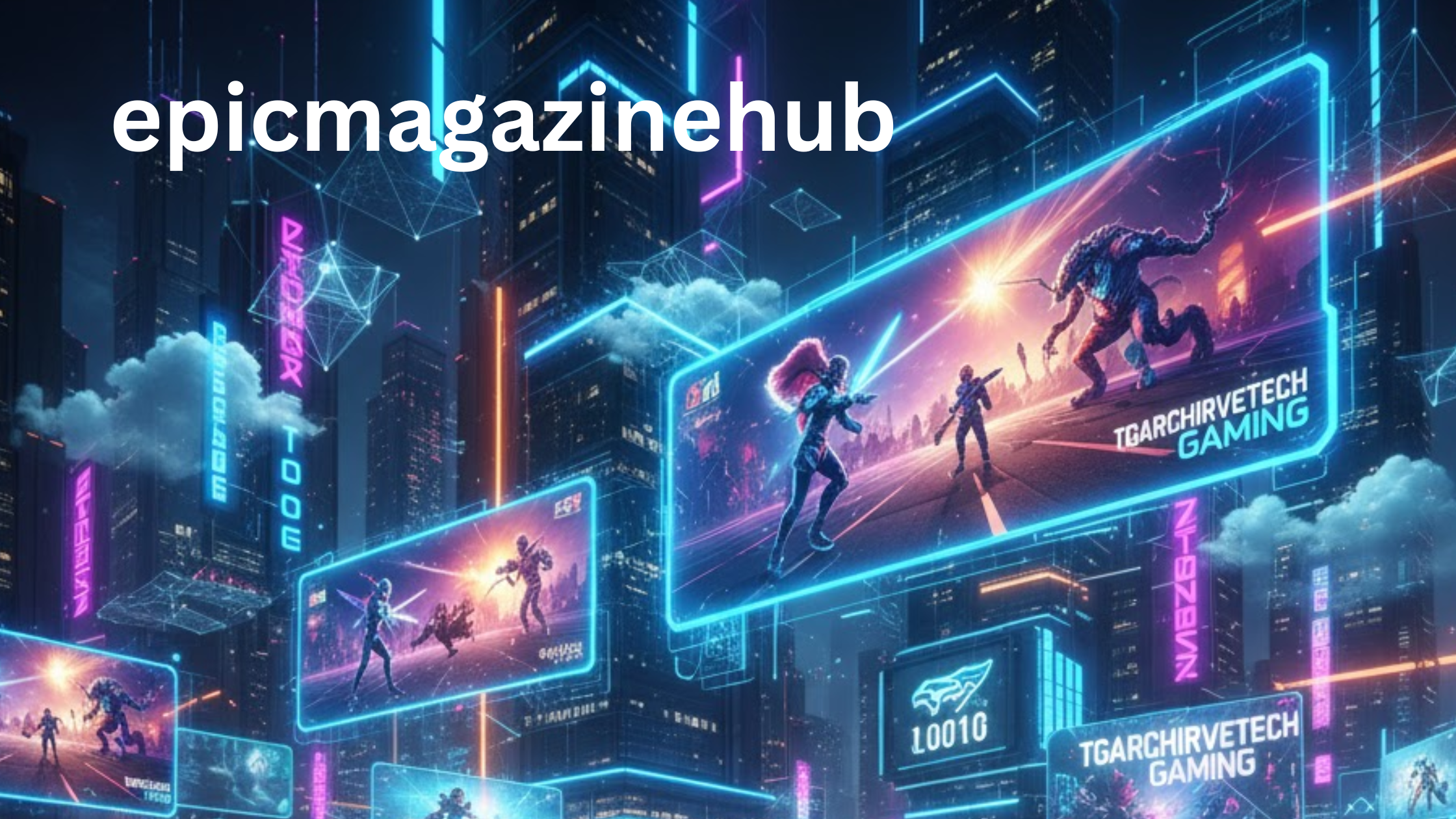Table Of Content
ToggleIntroduction: When a Strange Word Sparks a Real Discussion
The internet loves mystery, and Tgarchirvetech is one of those words that made people curious. It sounds futuristic, a mix of tech and gaming, yet no one knows where it came from. While many argue it might be a made-up term, it started an honest conversation about what truly defines the future of gaming.
Gaming today isn’t just about pixels and controllers. It’s about intelligent systems, real emotions, global communities, and immersive experiences. Tgarchirvetech Gaming Trends captures this transformation—a phrase that symbolizes how technology changes how we play, connect, and even make a living through games.
What Is Tgarchirvetech? The Mystery Word with a Real Meaning
At first glance, Tgarchirvetech doesn’t belong to any company, brand, or technology. Search engines show bits and pieces of references, mostly blogs or experimental discussions. Still, it mirrors what’s happening in gaming: innovation at full speed, driven by artificial intelligence, cloud systems, and player-centered design.
Even though the term itself might not exist in any dictionary, it represents a powerful idea—the fusion of technology, creativity, and community. That fusion defines the current and upcoming gaming trends in 2025 and beyond.
How Fake Words Like Tgarchirvetech Become Real Discussions
The rise of unknown words in the tech space is not new. Sometimes a strange phrase goes viral, forcing people to ask questions. In the process, real topics emerge. Tgarchirvetech may not have a physical company behind it, but it connects to genuine innovations transforming the gaming world.
Each year, we see gamers and developers exploring deeper forms of play. AI is learning how we move and react. Virtual reality is taking players inside stories. The cloud makes it possible to play massive games from any device. So even if Tgarchirvetech began as a digital myth, it now stands for the unstoppable growth of technology in gaming.
Cloud Gaming: Playing Without Boundaries
One of the strongest Tgarchirvetech Gaming Trends shaping the future is cloud gaming. It removes the limits of expensive hardware. Players can stream their favorite titles directly from powerful remote servers. Platforms like NVIDIA GeForce Now, Xbox Cloud, and Amazon Luna are making it possible to play console-quality games on tablets, laptops, or even smartphones.
This shift has also opened opportunities for small studios and local developers. Instead of focusing on consoles, they can design games that reach audiences globally through the cloud. That’s a Tgarchirvetech-style innovation—tech that democratizes access and makes gaming inclusive for all.
Mobile Gaming: The Always-On Experience
Smartphones have become the world’s most popular gaming device. Mobile gaming is no longer casual; it’s serious business. Games like PUBG Mobile and Genshin Impact prove that people are willing to invest time and money into portable entertainment.
Under the Tgarchirvetech Gaming Trends banner, mobile gaming represents the freedom to play anywhere. Developers are optimizing experiences for touch screens, 5G networks, and cloud synchronization. The line between mobile and console gaming keeps blurring.
Local employment in mobile game design has also surged, as studios seek developers, UX designers, and marketing experts who understand this fast-paced environment.
AI in Games: Smarter Worlds, Smarter Play
Artificial intelligence is rewriting the rules of play. In the Tgarchirvetech Gaming Trends ecosystem, AI acts like a co-creator. It builds levels, adapts difficulty, and personalizes stories for each player.
Imagine entering a world that learns your tactics and adjusts its challenges accordingly. AI-driven non-player characters (NPCs) can now express emotion, remember your choices, and evolve based on your actions. That’s storytelling beyond code—it’s dynamic interaction.
Games like No Man’s Sky and The Last of Us Part II use AI to craft organic environments. AI also helps developers cut production costs and accelerate creativity, proving how technology and art can work hand in hand.
VR and AR: Living the Game
Virtual Reality (VR) and Augmented Reality (AR) are no longer dreams. They’re gateways to digital worlds that feel tangible. In the context of Tgarchirvetech Gaming Trends, these technologies define immersion.
VR headsets transport you inside the action. AR games like Pokémon merge real life with virtual spaces. Mixed reality, powered by spatial computing, is the next level—where you can manipulate 3D objects and explore fully interactive worlds.
Developers now use VR for both fun and education. From gaming to healthcare simulations, the skills and technologies overlap. That connection creates jobs for programmers, artists, and engineers who design sensory experiences.
Esports and Social Gaming: Building Global Communities
The rise of Esports has transformed gaming into a cultural movement. Under the Tgarchirvetech Gaming Trends theme, competitive gaming represents more than entertainment—it’s a career.
Esports players compete on massive stages, while millions watch through live streams. Social platforms like Discord and Twitch have turned gaming into community hubs. People don’t just play—they connect, collaborate, and earn.
The local impact is enormous. Cities now host tournaments, train teams, and hire broadcasters. Gaming isn’t a hobby anymore; it’s a growing part of the digital economy.
Green Gaming: A Sustainable Future
Gaming innovation also brings responsibility. One of the most overlooked Tgarchirvetech Gaming Trends involves sustainability. As servers consume massive energy, the industry is shifting toward green practices.
Developers use efficient engines, recyclable materials, and eco-friendly packaging. Some companies offset carbon emissions by supporting renewable energy projects. Players are becoming more aware, preferring brands that respect the planet.
Green gaming isn’t just about saving electricity—it’s about creating a responsible culture that values balance between progress and preservation.
Procedural Generation: Endless Possibilities
Procedural generation is another defining element of Tgarchirvetech Gaming Trends. It allows developers to create massive, ever-changing worlds using algorithms instead of manual design.
This method saves time and costs, giving players a unique experience each time they play. From dungeons to landscapes, procedural generation gives gaming infinite replay value.
It’s not just a feature—it’s a philosophy that aligns with the spirit of innovation behind Tgarchirvetech: efficiency, creativity, and discovery.
Dynamic Storytelling: When Games Feel Alive
Storytelling in games has evolved beyond linear scripts. Thanks to intelligent systems, developers create stories responding to player choices.
Dynamic storytelling gives every gamer a personal experience. Choices matter; outcomes differ. Titles like Detroit: Become Human and Cyberpunk 2077 prove how emotion and technology coexist.
This emotional depth adds humanity to the Tgarchirvetech Gaming Trends conversation. It’s proof that innovation isn’t just about machines—it’s about feelings.
The Business Side: Investment and Local Opportunities
Behind every gaming innovation lies a growing market. Investors are watching closely as gaming technology merges with AI, blockchain, and VR. Startups working in this field attract funding faster than ever.
Locally, the Tgarchirvetech Gaming Trends model supports new opportunities. Game testing studios, development hubs, and esports teams are rising across smaller cities, offering stable jobs.
Gaming tech is not only entertainment; it’s a real career path. Programmers, animators, writers, and marketers contribute to this evolving ecosystem.
Challenges and Ethical Questions
Every trend comes with challenges. The race for innovation sometimes leads to burnout, data privacy issues, or unfair monetization.
The Tgarchirvetech Gaming Trends discussion must also include ethics—protecting players’ data, ensuring fair competition, and avoiding exploitative mechanics. Developers face the responsibility of creating not just immersive but also honest experiences.
Balancing innovation and integrity will define the industry’s future.
How to Spot Fake Tech Trends
In an age where anyone can invent new buzzwords, it’s essential to verify what’s real. To check if a concept like Tgarchirvetech is legitimate:
- Search for official websites or companies.
- Review trusted databases like Crunchbase or LinkedIn.
- Avoid sources that lack transparency.
- Check if developers or journalists mention it.
Critical thinking keeps gamers and professionals grounded. Understanding what’s real protects creativity from confusion.
The Real Future of Gaming: Beyond Tgarchirvetech
Whether Tgarchirvetech is real or fictional, the trends it symbolizes are undeniable.
Gaming is heading toward personalization, inclusivity, and sustainability. The line between player and creator keeps fading. Soon, players might help build the worlds they explore.
Every innovation—from AI to AR—points toward one truth: the future of gaming belongs to imagination.
Why This Matters
Understanding Tgarchirvetech Gaming Trends means understanding the direction of digital life itself. The gaming world has always predicted how humans interact with technology. From social media to metaverses, gaming sets the pace.
By studying these trends, developers can adapt, businesses can grow, and players can prepare for experiences that feel more alive than ever.
Conclusion
Tgarchirvetech might have started as a strange word, but it now represents something much larger. It stands for innovation, creativity, and the passion that drives the gaming community forward.
Every Tgarchirvetech Gaming Trend defines a piece of our digital evolution from AI to cloud systems, sustainability to storytelling. Gaming today mirrors humanity’s spirit—curious, connected, and constantly reinventing itself.
The next generation of games will not just entertain—they’ll teach, connect, and inspire. The term might be mysterious, but the vision is clear: the future of gaming is here, and it’s more human than ever before.
Explore More


